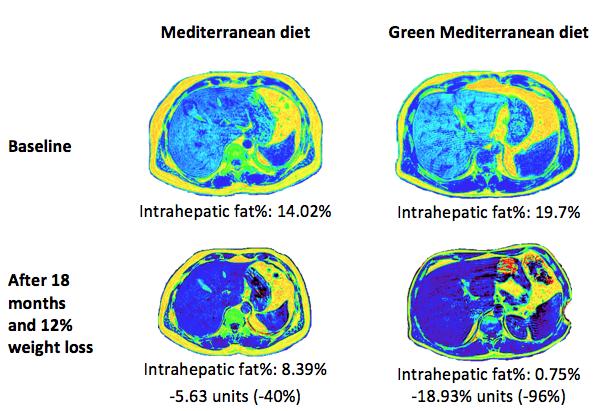A green Mediterranean (MED) diet reduces intrahepatic fat more than other healthy diets and cuts non-alcoholic fatty liver disease (NAFLD) in half, according to a long-term clinical intervention trial led by BGU researchers and a team of international colleagues.
The findings were published in Gut, a leading international journal focused on gastroenterology and hepatology.
"Our research team and other groups over the past 20 years have proven through rigorous randomized long-term trials that the Mediterranean diet is the healthiest," says lead researcher Prof. Iris Shai, an epidemiologist in the BGU School of Public Health who is also an adjunct professor at Harvard's T.H. Chan School of Public Health. "Now, we have refined that diet and discovered elements that can make dramatic changes to hepatic fat and other key health factors." Other Harvard investigators are Profs. Meir Stampfer and Frank Hu, chair of the Department of Nutrition at the Chan School.

Above: MRI images illustrate the green MED diet effect on hepatic fat loss. A green Mediterranean (MED) diet reduces intrahepatic fat more than any other healthy diet and cuts non-alcoholic fatty liver disease (NAFLD) in half.
NAFLD affects 25% to 30% of people in the United States and Europe. While some fat is normal in the liver, excessive fat (5% or higher) leads to insulin resistance, type 2 diabetes, cardiovascular risk, as well as decreased gut microbiome diversity and microbial imbalance. Since no drug is currently available to treat fatty liver, the only intervention is weight loss and curtailing of alcohol consumption.
This MRI-nutritional clinical trial (called Direct-Plus), conducted by an international research team led by Prof. Shai is the first to develop and test a new green Mediterranean diet. This modified MED diet is rich in vegetables, includes a daily intake of walnuts (28 grams), and less processed and red meat. It is enriched with green components, high in polyphenols, including three to four cups of green tea/day and 100 grams (frozen cubes/day) of a Mankai green shake. Mankai, an aquatic green plant also known as duckweed, is high in bioavailable protein, iron, B12, vitamins, minerals, and polyphenols.
"Addressing this common liver disease by targeted lifestyle intervention might promote a more effective nutritional strategy," says Dr. Anat Yaskolka-Meir, first author and member of BGU's School of Public Health. "This clinical trial demonstrates an effective nutritional tool for NAFLD beyond weight loss."
This 18-month trial DIRECT-PLUS began in 2017 at the Nuclear Research Center Negev in Dimona, Israel, when 294 workers in their fifties with abdominal obesity were randomly divided into three groups: healthy dietary regimen, Mediterranean diet, and green Mediterranean diet. In addition to the diet, all the participants were given a physical exercise regimen with a free gym membership. The participants underwent MRI scans to quantify the exact proportion of excess intrahepatic fat before and after the trial.
The results showed that every diet led to liver fat reduction. However, the green MED diet resulted in the greatest reduction of hepatic fat (-39%), as compared to the traditional Mediterranean diet (-20%) and the healthy dietary guidelines (-12%). The results were significant after adjusting for weight loss.
Overall, the green MED diet produced dramatic reductions in fatty liver. NAFLD prevalence dropped from 62% at baseline to 31.5% in the green Mediterranean group, down to 47.9% in the Mediterranean group, and 54.8% in the healthy dietary regimen group.
Specifically, greater Mankai and walnut intake and less red/processed meat intake were significantly associated with the extent of IHF loss, after controlling for other variables. Both MED groups had significantly higher total plasma polyphenol levels. More specific polyphenols, found in walnuts and Mankai, were detected in the green MED group. The researchers hypothesize the effect of polyphenols and the reduction in red meat play a role in liver fat reduction.
###
The research team included: BGU researchers Ehud Rinott, B.Sc.; Gal Tsaban, M.D., M.P.H.; Hila Zelicha, R.D., M.P.H.; Alon Kaplan, B.Sc.; Philip Rosen, Ph.D. Soroka University Medical Center researchers: Aryeh Shalev, M.D. and Ilan Shelef, M.D. Harvard University researchers: Frank B. Hu, M.D., Ph.D. and Meir J. Stampfer M.D. Other researchers: Ilan Youngster, M.D., M. MSc. of Assaf Harofeh Medical Center; Matthias Blüher M.D., Ph.D., Uta Ceglarek Ph.D. and Michael Stumvoll M.D., Ph.D. of the University of Leipzig; Kieran Tuohy, Ph.D.; Camilla Diotallevi, MSc and Urska Vrhovsek, Ph.D., of the Fondazione Edmund Mach.
This work was funded by grants from the Deutsche Forschungsgemeinschaft (DFG, German Research Foundation) - Project number 209933838 - Collaborative Research Center SFB1052 "Obesity Mechanisms" to Prof. Shai (SFB-1052/B11); Israel Ministry of Health grant 87472511 to Prof. Shai; Israel Ministry of Science and Technology grant 3-13604 to Prof. Shai; California Walnuts Commission to Prof. Shai and the Project "Cabala Diet & Health" which received funding from the European Union's Horizon 2020 research and innovation grant agreement No 696295 - ERA-Net Cofund ERAHDHL "Biomarkers for Nutrition and Health implementing the JPI HDHL objectives" supported polyphenol analyses at FEM (to K Tuohy).
Media Coverage:
The Times of London
Israel 21C
Times of Israel
Medical Xpress